The fuss-free starter's guide to metrics tracking (20+ metrics included)

Ever burnt food while cooking before?
The mouth-watering smell of roasted vegetables or meat becoming an unpleasant odor is a warning sign to reduce the heat and avoid ruining your dinner.
Tracking metrics won’t turn you into a master chef overnight, but like how charred food shows you’ve overcooked it, tracking metrics helps you track progress towards business goals and helps you to respond to any issues proactively.
Which key metrics should you track and why? Let’s show you.
What are metrics?
Tracking business metrics answer:
- Are my team’s actions translating into quantitative (measurable) business results?
- How are we progressing towards that goal we set last quarter?
Each department has its own most important metrics to measure success. Sales teams rely on net revenue metrics to benchmark future sales revenue targets and measure their contribution to the business bottom line, while an SEO team might look at keyword rankings over time to see if what they’re doing is working.
Tracking key performance indicators (KPIs) vs. tracking metrics: What’s the difference?
KPIs measure performance towards a specific strategic goal, whereas metrics track overall department performance.
Think of KPIs as a subset of metrics.
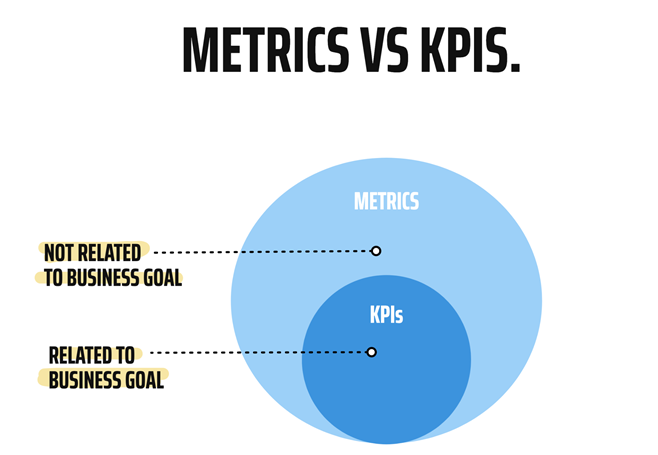
For example, if improving lead generation efforts for the next quarter is a vital part of your quarterly marketing strategy, you might set a KPI to improve the overall conversion rate. Here, landing page views are metrics as they aren't related to the business goal.
Tracking your metrics: The lifeblood of your business
Why go through all the trouble to track metrics?
What if we told you that tracking metrics properly helps individuals do their job, promotes teamwork, and helps you get support from senior management?
Here’s how.
Individual clarity: It provides insights on how to optimize efforts
Tracking metrics helps you deliver more effective campaigns.
Running a key email marketing campaign for a client? Track how your email sequences are performing. Low click-to-open rate? That might mean your content or email copy isn’t attracting your email list’s attention.
Without tracking metrics to signal potential issues or growth opportunities, you won’t know where to focus your attention or what to answer when the person reviewing your report asks, “why has our open rate been dropping in the last 3 months”.
Team clarity: It keeps your team focused by measuring success towards a goal
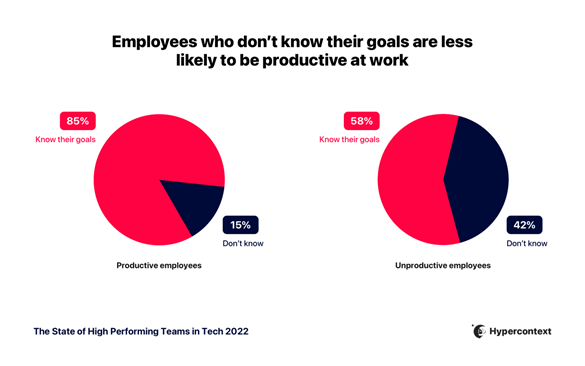
Source: Hypercontext
Clearly defined goals and metrics to measure progress connect your team to business strategy and organizational needs, helping each employee deliver better work.
Clear expectations and goals ranked the top factor for team productivity, while unproductive employees were 2.8 times more likely not to know their goals, according to a 2022 report by Hypercontext.
Thinking about your goals and how to measure success not only allows you to deliver better work, it also motivates your team to do the best work they can deliver.
Organizational clarity: Establishes marketing’s contribution to business goals.
Having issues getting an initiative or budget approved?
One reason that may hold you back: a lack of means to track success.
It’s hard to get support if you can’t prove you can generate results, and you can’t show results unless you’re tracking how you are performing.
Contently’s State of Content Marketing 2021 report shows a close relationship between documented goals and KPIs and support for a content marketing initiative.
- 66% of respondents said their head of marketing understands and supports the goals of their content marketing program.
- 68% of respondents have documented content marketing goals and KPIs.
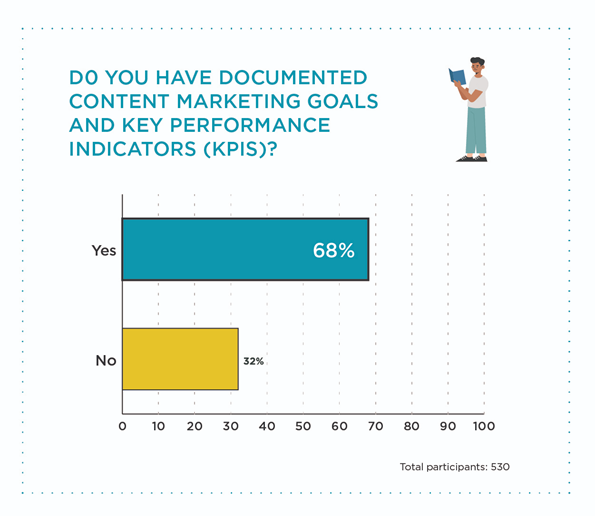
Source: Contently
So if you’re having trouble getting your campaigns and strategic plans approved by your clients or bosses, look at how you define your marketing goals and the metrics you measure.
Often, something convincing is missing there.
Am I measuring what matters? How to pick the right metrics to track your success.
There are a lot of metrics out there, each with its own story to tell.
So how do you pick the right ones?
Use these 2 guidelines when selecting your metrics.
- Does the metric closely relate to your main business aim? This depends from company to company. A company focusing on improving user retention rates might focus on customer satisfaction. In contrast, a company focused on user growth might measure the total number of sign-ups and conversion rates from a free trial.
- Does the metric measure progress towards a goal? Why have our sign-up rates dropped? Armed with these insights, your team can quickly create a plan of action or how to arrive at the tests necessary to answer this question.
Following these guidelines helps you avoid relying on vanity metrics, metrics that look good on paper, but don’t relate to your core business goals. They also don’t provide any meaningful insights to improve your performance.
For example, if you’re measuring the effectiveness of content towards business revenue, it would be more effective to measure the number of inquiries or conversion rate versus page views.
Getting started: 20 examples of suitable actionable metrics to track
Google Analytics metrics
Countless businesses, from service agencies to e-commerce companies rely on digital channels to drive revenue, brand awareness, and more. Google Analytics metrics measure the performance of your website and give you the insights to optimize these channels.
- Traffic sources. Tells you how people find your website or landing pages. Use this metric to help you understand which channels to focus your attention on for maximum ROI.
- Conversion rates across devices. Which device and content should I prioritize? Track and compare your conversion rates across desktop, tablet and mobile devices.
- Average session duration. A good starting high-level metric when reviewing your digital customer journey or evaluating the effectiveness of your content.
- Top landing pages. Landing pages in Google Analytics are the first web pages users see when they enter your site. Complement the insights from your traffic sources report by analyzing how visitors interact with your content and whether these visits turn into conversions.
- New vs. returning visitors. Find out if your campaigns help growth or user retention.
SEO metrics
SEO campaigns take months to see results, and you want to make sure all that work is bringing in results. Track performance and ROI with these essential metrics.
- Organic traffic. SEO’s primary aim is to bring in organic traffic to your website, and this metric shows if your efforts are working at a glance.
- Page speed. Page speed matters as a key Google ranking factor and user experience signal. More on how Google evaluates page experience,
- Domain authority. Predicts how well your domain ranks for specific terms.
- Referring domains. This is a metric to inform how many domains have linked to your site—key for tracking link-building efforts.
- Keyword ranking. Track the effectiveness of specific SEO efforts like outreach or link-building efforts by tracking keyword ranking trends.
Sales metrics and customer experience metrics
5 metrics to get you started on assessing your sales and customer retention efforts.
- Net promoter score. (NPS). NPS predicts your customer lifetime value and how your customers regard your company’s products and services.
- Lead-to-opportunity-to-customer conversion rate. This metric tracks the overall health of the sales pipeline. It answers 2 questions: whether marketing attracts the right leads and how effectively sales are closing them.
- Net revenue. Tracks how much money sales are really bringing in for the business. Useful for tracking financial performance in real-time.
- Churn rate. Tracks the customers you are losing in a specific timeframe.
- Percentage of revenue from new vs. existing customers. Is your money coming from growing existing accounts, or gaining new customers? This metric gives you insight into whether to improve in your acquisition or retention efforts.
Social media metrics
Social media is a fantastic tool for building brand awareness and community. But it’s also challenging to measure its contribution to business growth. These metrics might help.
- Engagement rate. Rather than the number of clicks or likes, look at the percentage of people interacting with your post to track social media engagement.
- Shares/Retweets. What percentage of your followers cared enough about your content to share it on their own timelines? One of the more powerful marketing metrics to track.
- Total followers vs. active followers. This metric tells you how much of your social media audience comprises real, engaged followers.
- Conversion rate. How many people took action and went to the link in bio or visited your website from social media? You’ll get those insights via this metric.
- Reach. This counts unique people who see your content and signals the percentage of followers seeing your content for the first time.
Learn more about specific metrics and KPIs here.
How to track your business metrics with DashThis in minutes
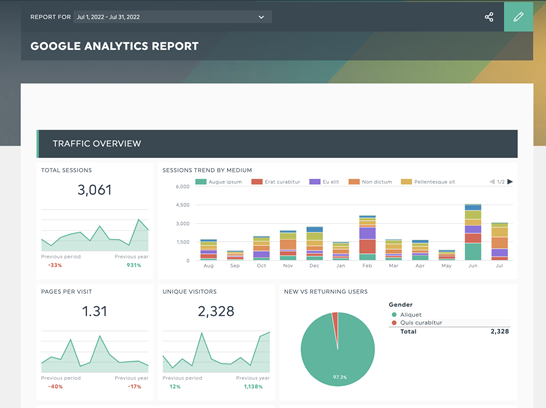
Get 20+ metric tracking templates just like this one with DashThis. Try it with your own data here.
Step 1: Sign up for an account with DashThis. Our free 15-day trial allows you to see if we're the right fit for you.
Step 2: Choose from over 40+ integrations and connect your marketing tools and data sources in seconds.
Step 3: Select the metrics to include in your report from DashThis’ preset widgets.
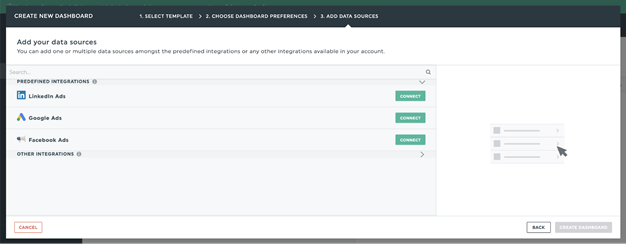
Step 4: Add as many data points as you need to set up your report. Once done, save your completed report as a template so you can reuse the template for future reports - saving even more time!
Step 5: View and share your dashboard. Share your dashboard with your client, internal teams, and project stakeholders with a click!
Ready? Start tracking your business performance with DashThis today.
Ready to start tracking your metrics?
Read More
Don’t miss out!
Automate your reports!
Bring all your marketing data into one automated report.
Try dashthis for free

